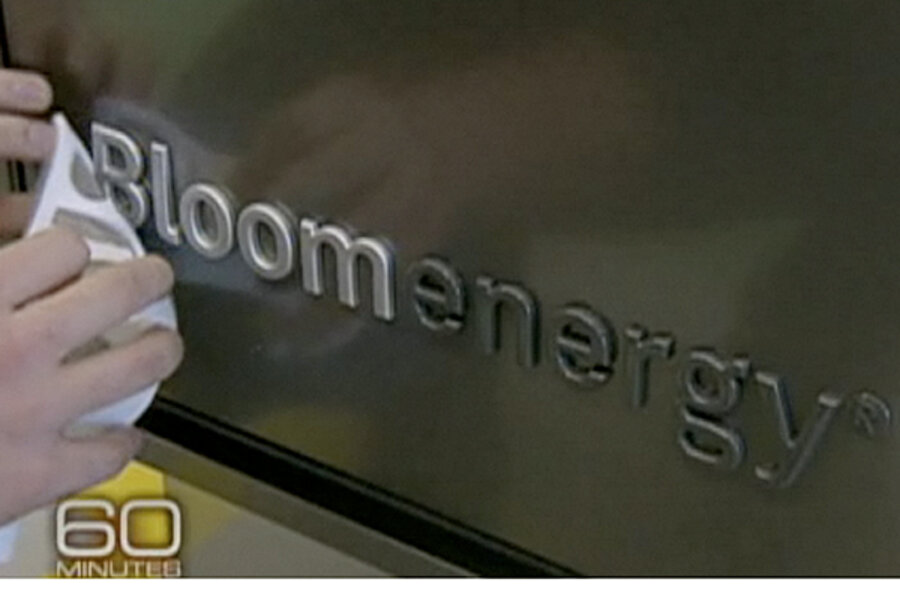Bloom Box: Frequently asked questions
Loading...
Silicon Valley clean tech start-up Bloom Energy is generating buzz for its promise to deliver a power plant in a box to every American home by 2020. The company claims its invention, the Bloom Box, will revolutionize the energy sector and one day replace the traditional power grid.
Bloom Energy officially announces the Bloom Box Wednesday. Following is a closer look at the company and its anticipated product.
What is Bloom Box?
Bloom Box is a personal "power plant in a box" that is claimed to produce energy cheaply and cleanly with no emissions. It’s made up of a collection of fuel cells, a kind of battery that uses oxygen, and fuel to produce electricity.
How does it work?
The Bloom Box’s fuel cells soak up oxygen on one side of the unit and fuel on the other. The oxygen and fuel combine within the cell and produce a chemical reaction that produces electricity with no burning, combustion, or power lines, according to a "60 Minutes" report on CBS that aired Sunday night. But, as the Horizons blog pointed out, Bloom Box may emit CO2, depending on the fuel used to power the unit.
What’s it made of?
Fuel cells are the building blocks of the Bloom Box. The cells are made of sand that is baked into tile-sized ceramic squares. Each cell is painted with green and black ink, sandwiched with metal alloy plates, and stacked into square bricks. Those bricks are housed in an outdoor-safe unit.
What sorts of fuel can it use?
Bloom Box creates electricity thanks to a chemical reaction between oxygen and fuel. The system can use fossil fuels, such as natural gas, or renewable fuels, such as bio-gas and even solar.
What kind of power-generating capacity does it have?
Each skinny fuel cell could power one light bulb. One refrigerator-sized Bloom Box, comprised of two stacks of fuel cells, could power an average US home (or two European homes, or four to six homes in India, depending on energy consumption levels). About 64 stacks of fuel cells could power a small business, such as a Starbucks franchise.
Who’s the person behind the invention?
Aerospace engineer K.R. Sridhar is CEO of Sunnyvale, Calif.-based Bloom Energy. Before founding Bloom Energy, Dr. Sridhar was a professor of aerospace and mechanical engineering, as well as director of the Space Technologies Laboratory at the University of Arizona. Sridhar once made devices for NASA, including one similar to the Bloom Box.
Who’s financing the venture?
Venture capitalist John Doerr, the man who funded Netscape, Amazon, and Google, is financing Sridhar’s invention to the tune of some $400 million. Other board members include former Secretary of State Colin Powell.
How much does a Bloom Box cost?
Corporate-sized Bloom Boxes cost between $700,000 and $800,000, Sridhar explained in his "60 Minutes" interview, but his goal is to bring the cost down to $2,000 to $3,000 to make them affordable for the average person. However, Bloom Energy likely plans to make use of federal subsidies for clean energy, including a 30 percent tax break for corporations.
Is anyone using them yet?
Yes. Google, FedEx, Wal-Mart, Staples, and eBay are among Bloom Energy’s most high-profile corporate customers. For instance, eBay now fuels 15 percent of its San Jose, Calif., campus with the five Bloom Boxes it installed nine months ago.
Is this too good to be true?
Possibly, say skeptics. Bringing the expensive technology to the masses is no easy task, as Michael Farrell indicated in a recent Monitor article. And it's nothing new, says Michael Kanellos, editor of Greentech Media, an online magazine that covers the clean-energy market. “People have tried fuel cells since the 1830s,” said Mr. Kanellos on "60 Minutes." “But they’re not easy. They’re like the divas of industrial equipment." Plus, he added, to be practical, "they have to work for 30 years nonstop. And then the box has to be cheap to make.”





